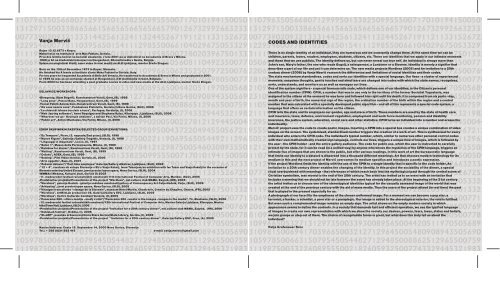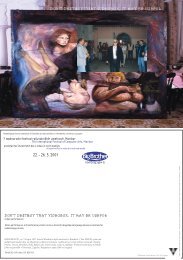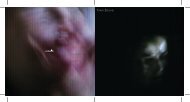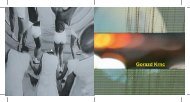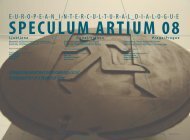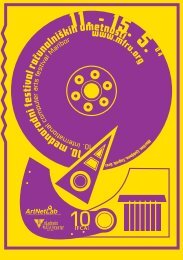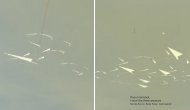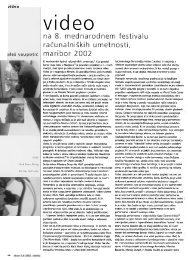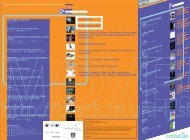Untitled - ArtNetLab
Untitled - ArtNetLab
Untitled - ArtNetLab
You also want an ePaper? Increase the reach of your titles
YUMPU automatically turns print PDFs into web optimized ePapers that Google loves.
Vanja Mervič<br />
Rojen 13.12.1973 v Kopru.<br />
Maturiral je na Instituto d´arte Max Fabiani, Gorizia.<br />
Prva dva letnika končal na beneški akademiji, v letu 2001 pa je diplomiral na Accademia di Brera v Milanu.<br />
1999 je bil na študentski izmenjavi na Hoogeshool, 3D-multimedia v Gentu, Belgija.<br />
Vpisan na magistrski študij smer video in novi mediji na ALU Ljubljana, mentor Srečo Dragan.<br />
Born on the 13th of December 1973 in Koper, Slovenia.<br />
He finished his A levels at Instituto d'arte Maks Fabiani in Gorizia, Italy.<br />
For two years he frequented Accademia di Belle Arti Venezia. He transferred to Accademia di Brera in Milano and graduated in 2001.<br />
In 1999 he was as an exchange student at Hoogeshool, 3-D multimedia in Gent, Belgium.<br />
From 2004 he has been attending a post graduate course in video and new media at the ALU, Ljubljana, mentor Srečo Dragan.<br />
DELAVNICE/WORKSHOPS:<br />
-Bloegroup, (Sam Bogart), Kunstcentrum Voruit, Gent, (B), 1999<br />
-"Long pose", Pascal Bass, Hoogeschool, Gent, (B), 1999<br />
-Toonel Fabrik Amsterdam, Kunstcentrum Voruit, Gent, (B), 1999<br />
-"Da cosa nascie cosa", Fondazione Pistoletto, Gorizia,(I)-Nova Gorica, (SLO), 2006<br />
-"Le chiavi di Ichnos tra cielo e terra", Perfugas, Sardinija, (I), 2006<br />
-"Web Jay-ing software", Anne Roquigny and Stephane Kyles, Kiberpipa , Ljubljana, (SLO), 2006<br />
-"Wherever we go - Ovunque andiamo", z Adrian Paci, Via Farini, Milano, (I), 2006<br />
-"Public art", Antoni Muntadas, Via Farini, Milano, (I), 2006<br />
IZBOR SKUPINSKIH RAZSTAV/SELECTED GROUP EXHIBITIONS:<br />
-"Ex Tempore", Piran, (2. nagrada/2nd prize), (SLO), 1996<br />
-"Nuove Figure", Galerija /Gallery Tragetto, Venezia, (I), 1996<br />
-"Linguaggi in diagonale", Lecce, (I), 1997<br />
-"Salon 1", Museo della Permamaente, Milano, (I), 1998<br />
-"Rainbow for dinner", Kunstcentrum Voruit, Gent, (B), 1999<br />
-"Waiting", Kunstcentrum Voruit, Gent, (B), 1999<br />
-"Octavo", ACEK, Gent, (B), 1999<br />
-"Sewing", Film Video monitor, Gorizia, (I), 2000<br />
-"Arte oggetto", Buje, (I), 2001<br />
-"Začasni delavec"/"Part time employee" Galerija/Gallery Alkatraz, Ljubljana, (SLO), 2002<br />
-"12 + 4", razstava ob vstopu Slovenije v EU z Vasjo Kokelj, Ivem Tabarjem/an exhibition with Ive Tabar and Vasja Kokelj for the occasion of<br />
Slovenia entering United Europe, javni prostor/open space, Nova Gorica, (SLO), 2004<br />
-MMMArt Medana, Kulturni dom, Gorizia (I) 2005<br />
-11. mednarodni festival računalniških umetnosti/11th International Festival of Computer Arts, Maribor, (SLO), 2005<br />
-Predstavitev projekta/Presentation of the project "Wordless", net.culture club MAMA, Zagreb, (HR), 2005<br />
-"Wordless", galerija Hodnik - galerija sodobne umetnosti/gallery of Contemporary Art Celje-Hodnik, Celje, (SLO), 2005<br />
-"Arhipelag", javni prostor/open space, Nova Gorica, (SLO), 2005<br />
-"Vissages francofones - vissage de la Slovenie", museum Henri-Martin, Chantrerie, Crenier du Chapitre, Chaors, (FR), 2005<br />
-"Wordless", <strong>ArtNetLab</strong> production 05, Galerija/Gallery SVC, Ljubljana, (SLO), 2005<br />
-"Wordless", Centro Culturale Candiani Venezia, (I), 2005<br />
-"Panorama 360 - slika v mediju - medij v sliki"/"Panorama 360 - media in the images - images in the media", Tir, Mostovna, (SLO), 2006<br />
-12. mednarodni festival računalniških umetnosti/12th International Festival of Computer Arts, Mestna Galerija Ljubljana, Kiberpipa, Mestna<br />
hiša/Town Hall, Ljubljana, (SLO), 2006<br />
-Predstavitev projekta/Presentation of the project "Invitation for a 20th century dinner", net.culture club MAMA, Zagreb, (HR), 2006<br />
-"DobiaLab festival", Dobbia, (I), 2006<br />
-"XL-ART", posoška državna knjižnica Stara Gorica/State Library, Gorizia, (I), 2006<br />
-Predstavitev projekta/Presentation of the project "Invitation for a 20th century dinner", Galerija/Gallery ESC, Graz, (A), 2006<br />
CODES AND IDENTITIES<br />
There is no single identity of an individual, they are numerous and we constantly change them. At the same time we can be<br />
children, parents, lovers, readers, employees, students, citizens, etc. There are identities that we apply in our intimate moments<br />
and those that we use publicly. The identity defines us, but can never reveal our true self. An individual is always more than<br />
John's son, Mary's father, the one who reads Gogolj, a salesperson, a Londoner or a Slovene. Identity is merely a signifier that<br />
describes a part of our life and yet it can determine us. The new media projects Wordless (2005) and An invitation to a 20th<br />
century dinner (2006) by Vanja Mavrič research the differences and limitations of social identities and their codes.<br />
The state mechanism standardises, codes and sorts our identities with a special language. Our lives - a cluster of experienced<br />
moments, unspoken thoughts, gentle touches and shed tears are changed into codes with which the state names, recognises,<br />
sorts, understands, and monitors us as well as manages our lives.<br />
One of the system signifiers - a special bureaucratic code, which defines one of our identities, is the Citizen's personal<br />
identification number (CPIN). CPIN, a number that was in use only in the territory of the former Socialist Yugoslavia, was<br />
assigned to the citizen at the moment he was born and followed him right until his death. It is composed from six parts - day,<br />
month and year of birth, the numerical sign of the region, the ordination number of the birth within the region and a control<br />
number that was calculated with a specially developed public algorithm - and all of this represents a special code system, a<br />
language that offers us certain information on the citizen.<br />
CPIN tells the state and its employers our gender, age and place of birth. These numbers are used by the state at health care<br />
and insurance, taxes, defence, environment regulation, employment and work force monitoring, pension and disability<br />
insurance, the justice system, education, social care and other statistics. CPIN turns an individual into a number and erases his<br />
individuality.<br />
Mervič' project uses the code to create poetic images. Inputting a CPIN into a special box creates a unique combination of video<br />
images on the screen. The systemised, standardised number triggers the creation of a work of art. This is synthesised for every<br />
individual who enters the CPIN code. The individual's typical number, which, similar to numerous other personal control codes<br />
with their own mathematically created sign language, controls our lives, triggers a unique flow of images, which is followed by<br />
the user - the CPIN holder - and the entire gallery audience. The code for public use, which the user is instructed to carefully<br />
protect by the state, for it can be read (in a unified way) by anyone who knows the mysteries of the CPIN language, triggers an<br />
intimate flux of images that are shown to the public, but offer various readings. In this work of art the bureaucratic language<br />
that limits our identity to a dataset is dispersed into a thousand different meanings. Art that chooses modern technology for its<br />
medium in this and the next project of Mervič overcomes its medium specifics and introduces a poetic expression.<br />
If the project Wordless limits the identity with the use of the CPIN to a single identity that is specific to the code holder, An<br />
invitation to a 20th century dinner enables the changing of the identity. In this project the sociability of the dinner, a special<br />
ritual overburdened with meanings - the references of which reach back into the mythological past through the central scene of<br />
Christian symbolism, was moved to the end of the 20th century. The artist has invited us to an event with an invitation that<br />
includes a warning that we should not be late however the event has already taken place. At the beginning of the 21st century<br />
the artist invites us to choose one of the stereotypical identities typical for the casually assessed image of the world that was<br />
created at the end of the previous century with the aid of mass media. Thus the users of the project attend (in real time) the past<br />
that is played in the present especially for us.<br />
A photograph of our face fills the emptiness of the chosen uniformed image. For a moment we can become a pop star, a<br />
terrorist, a hacker, a scientist, a porn star or a paraplegic. Our image is added to the stereotypical exterior, the void is fulfilled.<br />
But even such a complemented image remains an empty sign. The artist shows us the empty modern society in which<br />
appearance seems to define the contents. In a society that demands fast and efficient operation, we use the typified language<br />
of images to create our own representation with which we show the society our desires, powers, fears, loves, status and beliefs,<br />
we join groups or step out of them. The choice of recognisable forms is great, but what does this truly tell us about the<br />
individual<br />
Naslov/Address: Cesta 15. Septembra 14, 5000 Nova Gorica, Slovenija<br />
Tel.: + 386 (0)31 883 415<br />
e-mail: vanja.mervic@gmail.com<br />
Petja Grafenauer Krnc


